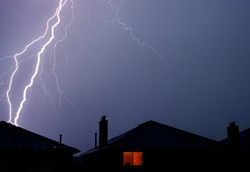Thunderstorms

Thunderstorms
Storms develop quickly and can occur with little to no warning. Heavy winds and lightning caused by storms can cause extended power outages, uprooted trees, landslides, and downed or broken utility lines. Furthermore, heavy rains can cause flash floods.
During the storm:
- Keep an eye on the sky. At the first sign of severe weather (darkening skies, lightening, increased wind), tune in to radio or TV for the latest weather information.
- Avoid handling metal, electrical equipment, telephones, bathtubs, water faucets and sinks, because electric current from lightening can travel through wires and pipes.
- If you are outside, take cover in a stable facility.
- Avoid the following:
- Natural lightning rods such as a tall isolated tree in an open area
- Isolated sheds or other small structures in open areas
- Anything metal (tractors, farm equipment, motorcycles, golf carts, golf clubs, and bicycles
- Observe the 30/30 lightning safety rule: Go indoors if, after seeing lightning, you cannot count to 30 before hearing thunder. Stay indoors for 30 minutes after hearing the last clap of thunder.
- Avoid walking through water that has seeped in your home - it may contain hazardous materials.
- If you are asked to evacuate your home, disconnect all electrical appliances.
- Call 311 to report fallen trees or tree limbs, or clogged catch basins.
- Call 311 to report flooded streets.
- Avoid downed power lines and broken gas lines. Report them to 311.
After the storm:
- Assess your immediate environment.
- Report fallen trees, flooded streets or damaged public utilities to proper department.
- Stay tuned to local weather stations for updated information.
